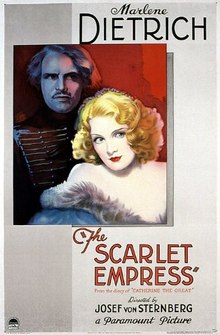The Scarlet Empress
| The Scarlet Empress | |
|---|---|

French film poster
|
|
| Directed by | Josef von Sternberg |
| Produced by |
Emanuel Cohen Josef von Sternberg |
| Written by |
Catherine II (diary) Manuel Komroff (diary arranger) Eleanor McGeary |
| Starring |
Marlene Dietrich John Lodge Sam Jaffe Louise Dresser C. Aubrey Smith |
| Music by | Bernhard Kaun |
| Cinematography | Bert Glennon |
| Edited by | Josef von Sternberg Sam Winston |
| Distributed by | Paramount Pictures |
|
Release date
|
|
|
Running time
|
104 minutes |
| Country | United States |
| Language | English |
| Budget | $900,000 |
The Scarlet Empress is a 1934 American historical drama film made by Paramount Pictures about the life of Catherine the Great. It was directed and produced by Josef von Sternberg from a screenplay by Eleanor McGeary, loosely based on the diary of Catherine arranged by Manuel Komroff. Substantial historical liberties are taken.
The film stars Marlene Dietrich as Catherine, supported by John Davis Lodge, Sam Jaffe, Louise Dresser, and C. Aubrey Smith. Dietrich's daughter Maria Riva plays Catherine as a child.
Sophia Frederica (Dietrich) is the daughter of a minor German prince and an ambitious mother. She is brought to Russia by Count Alexei (Lodge) at the behest of Empress Elizabeth (Dresser) to marry her nephew, Grand Duke Peter (played as a half-wit by Jaffe in his film debut). The overbearing Elizabeth renames her Catherine and reinforces the demand the new bride issue an heir to the throne.
Unhappy in her marriage, Catherine finds solace with the womanizing Alexei, first and foremost a paramour of the much-older Elizabeth. Rebuffed at this discovery, she takes lovers among the Russian Army to court its favor. When the old Empress dies seventeen years into their marriage, Peter ascends to the Russian throne and takes steps against his wife. Soon Catherine plots and exercises a coup, beginning a reign as Empress that will leave her known to history as Catherine the Great.
The film is notable for its attentive lighting and the expressionist art design von Sternberg creates for the Russian palace. In film critic Robin Wood's words:
...
Wikipedia
